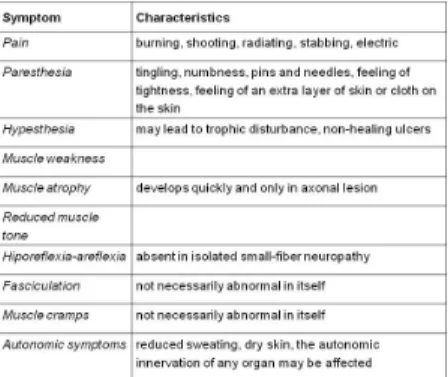III./9.2. General symptoms of peripheral nervous system disorders
Table 2 summarizes the signs and symptoms of peripheral nervous system disorders.
Table 2: General symptoms of peripheral nervous system disorders
In general, sensory symptoms occur first, because sensory fibers are more vulnerable both to compression (e.g. in tunnel syndromes) and in systemic diseases (e.g. diabetes mellitus). Positive sensory symptoms (pain, paresthesia) are more characteristic than negative sensory symptoms (hypesthesia). Pain, so called neuropathic pain resulting from peripheral nerve damage (Fig. 5 shows the different types of pain) differs both in character and treatment from nociceptive or inflammatory pain due to the physiological stimulation of pain receptors. In neuropathic pain, the structure conveying pain is damaged, which leads to pain in the absence of painful stimuli. Neuropathic pain is burning, shooting, radiating in character, which worsens during the night or rest and is associated with tingling sensation or other paresthesias. Allodynia is also very typical, which refers to pain provoked by light touch of the affected skin area. Traditional (non-steroid type) pain killers are not effective in neuropathic pain; effective drugs are shown by Table 3. When a given nerve is damaged, positive sensory symptoms are usually limited to the innervation territory of the nerve, but not necessarily. For example, in carpal tunnel syndrome, patients often complain of pain in the whole arm.
Fig. 5: Different types of pain Table 3: Drug classes effective in neuropathic pain
Negative sensory symptoms (hypesthesia) and motor symptoms are limited to the innervation territory of the nerve. Therefore, it is possible to ascertain the damaged nerve based alone on anatomical knowledge when the area of sensory loss and paretic muscles are established. It is also important to mention that sensory loss of dermatomal distribution caused by radicular or spinal segmental lesions is not well delineated, because there is a great degree of overlap between adjacent dermatomes. On the
contrary, sensory loss due to a peripheral nerve lesion has sharp, well delineated borders.
Motor symptoms include: paresis, muscle atrophy, muscle hypotonia, and fasciculation.
Motor symptoms are usually late symptoms and are signs of more severe damage.
Decreased or absent deep tendon reflexes may be due to both sensory and motor fiber
damage. Generalized hypo-, areflexia is usually a sign of polyneuropathy, however, reflexes may still be normal in early stage with only very distal symptoms. Tendon reflexes are also normal in the so called small-fiber neuropathy involving only small sensory fibers (Aδ, C), because muscle spindles are innervated by the large sensory fibers (Ia).
